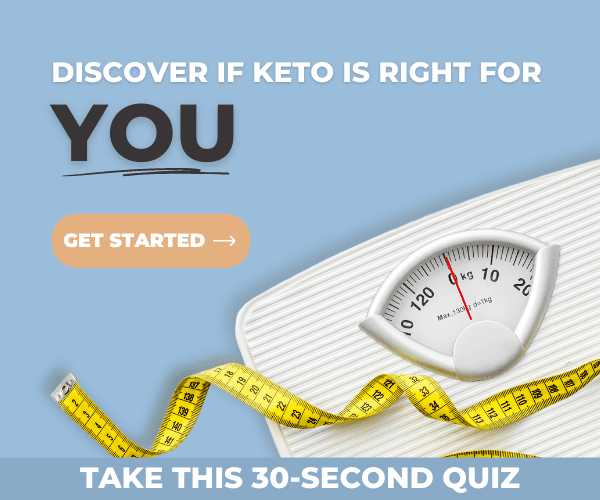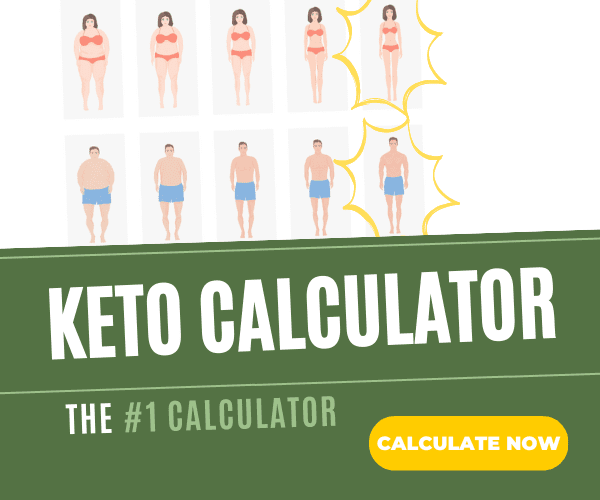Keto Diet Myths That You (Probably) Still Think Are True

Any new trend sees it’s fair share of criticism, but keto diet myths are particularly stubborn, even after being proven wrong. Following a keto diet can be hard without the right guidance or understanding. Unfortunately, there is so much noise on social media and news outlets every day about various diets and techniques that claim to be the holy grail for improving body composition. Recently, the ketogenic diet has exploded and taken the brunt of the publicity, good and bad. Popular media outlets and fitness enthusiasts seize these opportunities in order to cause a stir and gain some traction since more and more people are hearing about the ketogenic diet–even our friend Vinny from the Jersey Shore (@ketoguido) recently embarked on this way of eating and has completely transformed his life. If a hardcore Italian can do it, you can too–and here’s why you might want to.
Where the Critics are Right: This Isn’t Something “New”

Often termed the “keto diet,” this style of eating isn’t something that’s new. The concept of restricting carbohydrates to lose weight and improve overall health dates back to the mid-1800s. Jean Anthelme Brillat-Savarin, a French lawyer, politician, and “Father of low- carbohydrate diets,” was the first to connect obesity and carbohydrates. In his book The Physiology of Taste (1825), he states that a major cause of obesity “is the floury and starchy substances which man makes the prime ingredients of his daily nourishment… All animals that live on farinaceous food (containing starch) grow fat willy-nilly; and man is no exception to the universal law.” [1]
Not long after, English undertaker William Banting began following a low-carbohydrate diet on the advice of Dr. William Harvey. Numerous medical treatments, starvation diets, and extreme exercise hadn’t worked for this five-foot-five, 202-pound sixty-five-year-old, but by limiting carbohydrates—he cut bread, sugar, potatoes, milk, and beer out of his diet—he saw an incredible transformation. Banting was so ecstatic with his weight loss that in 1863 he published A Letter on Corpulence, which sold thousands of copies. [2] By 1866, London and much of Europe were experiencing full Banting-mania. Though not entirely the same as a keto diet, the Banting diet paved the way for later carbohydrate-restriction strategies, and is still extremely popular in South Africa, with advocates like our friend and colleague Professor Tim Noakes, co-author of The Real Meal Revolution. [3]Fast forward a few decades, and a fitness guru named Bernarr Macfadden launched his own magazine, Physical Culture, which set out to educate readers on the importance of being physically active, eating healthy, limiting tobacco, alcohol, and even white bread (which he called “the staff of death”). Macfadden went on to open a sanitarium, where he advocated for physical activity and fasting–eventually leading one of his clients, Upton Sinclair, to publish the book The Fasting Cure in 1911. Inspired by some of this work, Dr. H.R. Geyelin, a prominent physician from New York, began incorporating fasting techniques with his clients after seeing the tremendous results it had for his younger cousin who had epilepsy. [4] In fact, after putting thirty epilepsy patients on a twenty-day fast, he found that 87 percent became seizure-free. Geyelin went on to state, “When one wanted to turn a clouded mentality to a clear one it could almost always be done with fasting.” [4]

This concept that fasting could lead to drastic improvements in epileptic patients both fascinated and confused scientists across the world. At the Mayo Clinic, Dr. Russell Wilder was looking to fat as the key to receiving the benefits of fasting while still consuming calories. When the body metabolizes fat, particles called ketone bodies are produced, and it’s these ketones the body utilizes as fuel. Wilder proposed that the positive benefits achieved via fasting were likely due to ketonemia, high levels of ketones in the blood. With that in mind, he suggested that this state (which would eventually become known as ketosis) could be achieved by means other than fasting, such as minimizing carbohydrate intake and having a high fat intake. Wilder immediately began putting his epileptic patients on a ketone-producing diet and coined the term by which we know it today: “ketogenic diet.” [5]
By now, I think we are at a point where we are slowly starting to rebound from the nonsense and confusion of Ancel Keys’s Seven Countries Study. I’m sorry Ancel, but fat is back, and it’s here to stay. Thanks to individuals like Dr. Robert Atkins, who outlines a high-fat, low-carbohydrate approach in his Dr. Atkins’ Diet Revolution in 1972, low-carb, high-fat diets were popularized. Granted, it’s important to understand that the Atkins diet wasn’t necessarily a keto diet, nor do Atkins products fall within what I would term “ketogenic products,” but at least the concept of carbohydrate restriction and higher fat intake was conveyed at some level and paved a cleaner path for keto to take hold.
It couldn’t be clearer that keto is here to stay. The research surrounding various therapeutic and physical benefits is growing by the day. I look forward to getting up every morning and seeing my Google Scholar alerts about new studies on ketogenic diets, exogenous ketones, and everything else surrounding ketosis, since it serves as a reminder of how far this conversation has come, yet how much more we have to do. If there’s an approach that not only interests some of the most well-known athletes and celebrities, but also some of the top researches in oncology and cancer metabolism, then it certainly warrants a deeper look and clearer understanding.
Our goal at ketogenic.com is to help sift through the noise—to clear the air and provide people with actual insights and information. Due to recent noise and keto diet myths from certain media outlets, we would like to help answer and address some questions that may be confusing about the ketogenic lifestyle.
Keto Diet Myths: Keto is not a Palatable Diet
If this argument was being made two decades ago, I might be inclined to agree. I don’t know about you, but bacon, eggs, cobb salads, meat, vegetables, keto-friendly cookies, etc., all sound pretty appetizing to me. We are far beyond the days where keto was just copious amounts of MCT oil, heavy cream, butter, etc. Certainly, all of those can be part of a well-formulated keto diet, but when someone says keto isn’t “palatable,” I want to invite them into our kitchen with some of our recipe contributors, so they can get a look at some of the amazing recipes I get to try daily (some of them can be found here.)
I’m talking everything from pancakes and waffles, to brownies, cookies, and cakes, and everything in between – even bread (yes Oprah, I love you, but there is keto bread). This doesn’t even account for the hundreds of ketogenic products out on the market that support this lifestyle–on the go travel packets, desserts, etc. If a well-formulated ketogenic diet isn’t palatable, I don’t know what is. Kiss this keto diet myths goodbye.
Your Diet Needs to be 80–90% Fat
The amazing thing about science is that it’s constantly evolving as we study and learn new things. As mentioned above, the ketogenic diet really originated because of epilepsy. A lot of the early research done in this area did, in fact, utilize a diet that was 80–90% fat and, certainly for kids, this would likely be restrictive and “unpalatable.” Fortunately, we’ve come to realize through the work of Dr. Eric Kossoff and others that you likely don’t need to be as restrictive, EVEN when you are utilizing the diet for therapeutic purposes. For body composition and overall health in healthy individuals, you certainly don’t need to be at 90%–in fact, that would likely be detrimental due to being protein deficient.
Modified Atkins Diets (MAD) have been used since 2003, and to this day are still being utilized for both children and adults with drug-resistant epilepsy. “This ‘alternative’ ketogenic diet is started in clinic, without fasting, hospitalization, and restriction of protein, calories, or fluid intake. Now after 10 years of continued use, approximately 400 patients have been reported in over 30 studies of the modified Atkins diet as treatment for intractable seizures, with results demonstrating similar efficacy to the ketogenic diet and improved tolerability.” [6]
- For improvements in body composition, multiple studies have used varying ratios and seen elevations in blood ketones (an indication of successful keto-adaptation), as well as improvements in body composition.
- Our lab found drastic improvements in body composition with a 70–75% fat approach in individuals who were resistance training. [7]
Several other labs, studies, and anecdotal reports see marked improvements with far less than 90% of their calories as fat, whether people are resistance training, sedentary, fasting, or eating multiple meals per day. No need to beat a dead horse, but the 80–90% fat concept isn’t necessary and, if so, likely only under very specific therapeutic conditions.
Keto Diet Myths: You Can Only Have 10 Grams of Carbohydrates on a Keto Diet
I’m not even sure where this concept originated. Says who?!? Even Drs. Volek and Westman, two of the godfathers of ketosis, define a keto diet as “daily consumption of fewer than 50 g of carbohydrate, regardless of fat, protein, or caloric intake.” [8] Our colleague, Rachel Gregory, did the same in her recent paper looking at the effects of ketogenic diets in Crossfit athletes. [9]

Certainly, carbohydrate restriction is one of the main constituents of a well-formulated ketogenic diet, but an arbitrary number of 10 g doesn’t make sense. Sure, some people may need to restrict that much if they are utilizing the ketogenic diet for certain applications, but the large majority can consume more than that. Additionally, we are just starting to study the metabolic impact of various fibers, thereby elucidating whether it is the “total” or “net” carbohydrates that count. Without going into too much detail, we’ve done research showing that different fibers have different metabolic impacts, which result in you being able to consume more “carbohydrates” and still maintain a state of ketosis [10]. For more information on that concept, check out our article “Net Carbs and Fiber: Are Fibers Truly Ketogenic?”
Keto Diet Myths: Your Body Starts Breaking Down Muscle/Protein to Make Glucose
On paper, this sounds rational, right? Your carbohydrates are low, so your body goes into “starvation mode” and starts chipping away at all of that hard-earned muscle you’ve built over your lifetime in order to provide glucose…Not quite.
The concept of gluconeogenesis (making glucose from non-carbohydrate substances) is one of the most commonly discussed topics when it comes to the keto diet. Fortunately, our bodies are pretty incredible machines and, despite not having much of an exogenous supply of glucose from carbohydrates, they’re still able to make their own glucose through other ways on a ketogenic diet – one that doesn’t involve breaking down your muscle tissue. There are several plausible ways in which your body can do this:
- Your body can convert amino acids over into glucose. However, unlike what some people think in terms of breaking down muscle, our colleagues at Auburn University showed that animals placed on a long-term ketogenic diet have the same amount of branched chain amino acids – including leucine – meanwhile, they have a lower amount of alanine – a glucogenic amino acid. In short, our bodies are smart at using non-essential amino acids that can readily convert over to glucose to supply that energy.
- Two other substrates that can convert over are glycerol and lactate. Triglycerides are formed via three fatty acids and a glycerol molecule. During prolonged fasting or, in this case, with high amounts of fat breakdown (which occurs during ketosis), glycerol is released from the triglycerides in adipose tissue and may account for 20% of gluconeogenesis. [11] On the other hand, lactate can also contribute toward gluconeogenesis during exercise since lactate increases significantly and, therefore, may be shuttled toward aiding in this process.
Our lab has shown that ketones may actually be anabolic, which could be a reason why people are able to gain muscle on a ketogenic diet (publication coming soon). However, multiple studies have shown that they are anti-catabolic – meaning that they preserve muscle tissue and prevent important amino acids from being broken down. So, no, being on a well-formulated ketogenic diet won’t make you waste away.
Keto Diet Myths: Ketosis Makes You Acidic
Unfortunately, keto diet myths like this one stem from a misunderstanding of what ketosis is, and how that differs from ketoacidosis. In short, they are two very different and distinct metabolic states. Ketoacidosis occurs with uncontrolled ketone production, which is typically accompanied by high blood glucose concentrations (i.e., diabetes, which can cause DKA). With DKA, plasma ketone levels reach 10+ mmol/L, and the acidity of the blood increases. [12] The potential cause for harm comes from the alarming rise in acidity or lowering of pH in the blood. Several factors can contribute to this for type I, and sometimes even type II diabetics, but it is typically triggered by some type of illness or imbalance, or not taking an adequate dose of insulin.
However, during a state of ketosis in otherwise healthy individuals, the body is able to regulate blood acid concentrations tightly. Additionally, the ketone levels typically achieved with a strict ketogenic diet, intermittent fasting, and even exogenous ketones tend to range from .3-4 mM, which is far from the point of ketoacidosis. If your blood has a pH of less than 7, it’s acidic; if the pH is higher than 7, it’s basic, or alkaline (the opposite of acidic). Human blood is usually slightly alkaline, and its pH ranges from 7.35 to 7.45. Any deviation from that, even by the most modest of margins, can prove fatal. With DKA, not only do you have a high number of ketones, but blood glucose levels are usually greater than 250 mg/dL (for reference, fasting levels are around 80-100 mg/dL), and a blood (usually arterial) pH less than 7.3.
It’s important to not downplay the importance of treating ketoacidosis; however, at the same time, it’s important to understand that lowering your carbohydrate intake to achieve a state of nutritional ketosis is far different from ketoacidosis.
Keto Diet Myths: Accelerates Aging and Shortens Telomeres
The only rational reason I can come up with for why someone would think this is the case would be that people are still confusing “high-fat diet” research with ketogenic diets (*facepalm*). Unfortunately, one of the challenges of science is that researchers often give mice “high-fat” diets in order to induce obesity, cause insulin resistance, and speed up aging. However, this “high-fat” diet is anywhere between 30–60% fat and is accompanied by a high amount of carbohydrates (i.e., typical American fast food diet). People often confuse this with a low-carbohydrate, high-fat, ketogenic diet, which has been shown to do the exact opposite of this…
The point of this article is to help clear up some confusion for people who are perplexed by some recent popular media and influential individuals who have raised some of the points above. Whether you’re on a ketogenic diet or not, it’s important to be open-minded, yet make sure the information you are getting is trustworthy and backed by actual evidence.
I’ll be the first one to say that the ketogenic diet isn’t the holy grail by any means, but more and more research is being looked at for all of the neuroprotective effects [16] clinical applications, [17] cholesterol-lowering capabilities [18] and, of course, its body composition and fat loss benefits, [19] Sadly, as we get older, our brains and bodies aren’t able to respond to certain things the way they could when we were younger – one of those “things” is glucose. [20]
Who knows? A ketogenic lifestyle may be the answer you have been looking for. At the very least, you can rest easy from these keto diet myths.
References
Brillat-Savarin, J. A. (1825). The Physiology of Taste: Or Meditations on Transcendental Gastronomy, trans. MFK Fisher, New York, Everyman’s Library.
Banting, W. (1869). Letter on Corpulence, addressed to the public… with addenda. Harrison.
Noakes, T., Creed, S. A., Proudfoot, J., & Caradoc-Davies, T. (2014). The Real Meal Revolution: Changing the World, One Meal at a Time. Quivertree Publications.
Geyelin, H. R. (1921). Fasting as a method for treating epilepsy. Medical Record, 99, 1037-1039.
Wheless, J. W. (2004). History and origin of the ketogenic diet. In Epilepsy and the ketogenic diet (pp. 31-50). Humana Press, Totowa, NJ.
Kossoff, E. H., Cervenka, M. C., Henry, B. J., Haney, C. A., & Turner, Z. (2013). A decade of the modified Atkins diet (2003–2013): results, insights, and future directions. Epilepsy & Behavior, 29(3), 437-442.
Wilson, J. M., Lowery, R. P., Roberts, M. D., Sharp, M. H., Joy, J. M., Shields, K. A., … & D’Agostino, D. (2017). The Effects of Ketogenic Dieting on Body Composition, Strength, Power, and Hormonal Profiles in Resistance Training Males. Journal of strength and conditioning research.
Westman, E. C., Mavropoulos, J., Yancy, W. S., & Volek, J. S. (2003). A review of low-carbohydrate ketogenic diets. Current atherosclerosis reports, 5(6), 476-483.
Gregory, R. M., Hamdan, H., Torisky, D. M., & Akers, J. D. (2017). A low-carbohydrate ketogenic diet combined with 6-weeks of crossfit training improves body composition and performance. Int. J. Sports Exer. Med, 3, 1-10.
Lowery, R. P., Wilson, J. M., Barninger, A., Sharp, M. H., Irvin, C., Stefan, M., … & Wagner, R. (2018). The effects of soluble corn fibre and isomaltooligosacharides on blood glucose, insulin, digestion and fermentation in healthy young males and females. Journal of Insulin Resistance, 3(1), 1-6.
Vazquez, J. A., & Kazi, U. (1994). Lipolysis and gluconeogenesis from glycerol during weight reduction with very-low-calorie diets. Metabolism-Clinical and Experimental, 43(10), 1293-1299.
Cartwright, M. M., Hajja, W., Al-Khatib, S., Hazeghazam, M., Sreedhar, D., Li, R. N., … & Carlson, R. W. (2012). Toxigenic and metabolic causes of ketosis and ketoacidotic syndromes. Critical care clinics, 28(4), 601-631.
Roberts, M. N., Wallace, M. A., Tomilov, A. A., Zhou, Z., Marcotte, G. R., Tran, D., … & Imai, D. M. (2017). A ketogenic diet extends longevity and healthspan in adult mice. Cell metabolism, 26(3), 539-546.
Newman, J. C., & Verdin, E. (2014). Ketone bodies as signaling metabolites. Trends in Endocrinology & Metabolism, 25(1), 42-52.
Parry, H. A., Kephart, W. C., Mumford, P., Romero, M., Hann, C., Mobley, C. B., … & Kavazis, A. N. (2018). Lifelong Ketogenic Diet Feeding Increases Longevity, But Does Not Alter Oxidative Stress Markers in Rats: 371 Board# 212 May 30 11. Medicine & Science in Sports & Exercise, 50(5S), 82.
Maalouf, M., Rho, J. M., & Mattson, M. P. (2009). The neuroprotective properties of calorie restriction, the ketogenic diet, and ketone bodies. Brain research reviews, 59(2), 293-315.
Freeman, J., Veggiotti, P., Lanzi, G., Tagliabue, A., & Perucca, E. (2006). The ketogenic diet: from molecular mechanisms to clinical effects. Epilepsy Res, 68(2), 145-80.
Dashti, H. M., Mathew, T. C., Hussein, T., Asfar, S. K., Behbahani, A., Khoursheed, M. A., … & Al-Zaid, N. S. (2004). Long-term effects of a ketogenic diet in obese patients. Experimental & Clinical Cardiology, 9(3), 200.
Paoli, A. (2014). Ketogenic diet for obesity: friend or foe?. International journal of environmental research and public health, 11(2), 2092-2107.
Gage, F. H., Kelly, P. A., & Bjorklund, A. (1984). Regional changes in brain glucose metabolism reflect cognitive impairments in aged rats. Journal of Neuroscience, 4(11), 2856-2865.












You are welcome. Happy to do so.